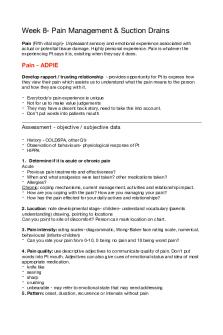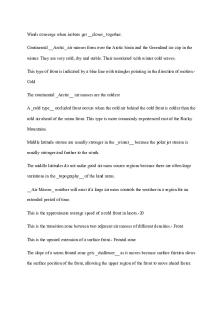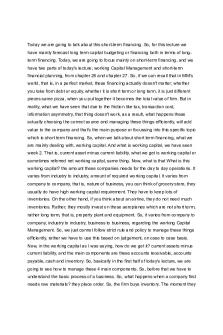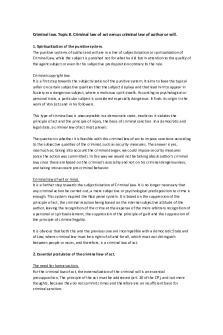LING3390 Lecture 8 PDF

| Title | LING3390 Lecture 8 |
|---|---|
| Author | Adeline Caceres |
| Course | Current Issues in Phonology |
| Institution | Macquarie University |
| Pages | 10 |
| File Size | 659.3 KB |
| File Type | |
| Total Downloads | 82 |
| Total Views | 122 |
Summary
lecture notes...
Description
LING3390 LING3390 Week 8: Syllables & Feet
Week 8: Lecture 8
Prosody – from Segments to Structures - The prosodic hierarchy is connected to segments and there is a level in between that is called the moras level and the syllable is also connected to the foot Native Speakers - Syllables are important when we think about Native Speaker’s intuitions o Native speakers can usually count syllables in a word Phonology – pho.no.lo.gy o Native speakers have clear intuitions about where to put syllable boundaries o They can identify the syllable boundaries Incidental – in.ci.den.tal *in.ci.de.ntal We have knowledge that the segments [nt] cannot occur together at the left edge of the 3rd syllable - Formal phonological operation that underlies both: syllabification - Native speakers of English also share intuitions about point of expletive infixation o absolutely abso-fricken-lutely *ab-fricken-solutely Representation of the Syllable - Internal structure of a syllable includes: onset (consonant), nucleus (vowel) and coda (consonant) - More internal structure: combining the nucleus and the coda in a rhyme which branches under the syllable o Syllable layer: branches off to an onset and rhyme (nucleus and coda) Nucleus - First element of the syllable, the syllable is built around the nucleus. It is the obligatory element of the syllable - It is often, but not always a vowel – the sonority hierarchy shows that the nuclei are mostly vowels, but sometimes they’re glides, liquids, or nasal stops - When the nucleus is deleted, stress or tone shifts elsewhere nucleus is the carrier of that suprasegmental information of the syllable - Rules of syllabification extend outward from the nucleus, we first determine which are the nuclei in a word, those are the cause of the syllable then we look at the onset and coda consonants - Nucleus also contributes to syllable weight Onset - The onset are any and all segments preceding a nucleus, they are tautosyllabic (within the same syllable) - Onsets are typologically preferred, meaning they are obligatory in some languages; forbidden in no language all languages allow for onsets - CV is the most common syllable template, may be the most ‘natural’ syllable - Rules of syllabification extend outward from the nucleus to the onset (the coda is the last element to be syllabified) - Onset does not contribute to syllable weight Coda -
Other end of the nucleus – they are any and all tautosyllabic segments following nucleus Typologically dispreferred: obligatory in no language; forbidden in some languages May be a phonologically restricted position:
LING3390 o
-
Week 8: Lecture 8 Constraints on segments licensed* in coda position – not all elements can occur in the coda position o Constraints on nucleus-coda combinations – what can occur in the coda depends on the nucleus and vice versa, which is one reason to say the nucleus and coda are somewhat closer related to each other than related to the onset o Constraints on complexity o Coda is target of special phonological processes Rules of syllabification extend outward from the nucleus to the onset (the coda is the last element to be syllabified) Open syllable – no coda [ba] versus close syllable – coda [barn] Coda can contribute to syllable weight
Constraints on Nucleus-Coda combinations: - The word /sing/ has an onset – nucleus – coda. - Altering the word and putting in a long vowel as the nucleus creates an ungrammatical word. This is because it is not a possible word of English. o *VːŋC0]σ - There is a restriction where short vowels can only precede /ŋ/ Coda target of special phonological processes - Syllable-final obstruent devoicing /hud/ /hudə/ /du/ /xədu/ Underlying Form .hud.
.hu.də. .du.
.xə.du.
Syllabification
.hut.
----
----
[+obs] [-voice] / ____]σ
----
[.hut.] [.hudə.] [.du.] [.xə.du.] -
syllable structure can specify the context in which a rule applies
Surface Form
It is a phonologically restricted position – not everything can happen in the coda – can’t have all types of consonants there It is the last element to be syllabified
Representation of the Syllable: Terms and Notation - Two internal structures: one with rhyme, and one without
Notation: - C= - V= - σ= - . = - ]σ = - *=
any consonant any vowel syllable syllable boundary (in syllabification) syllable boundary (in rules; note that this is the right edge) ungrammatical
Phonotactics: Syllable Templates - Phonotactics: The principles of phonological well-formedness in a particular language Syllable Templates: - Number of different syllable types - Structure and content of nuclei - Complexity of onset structures
LING3390 Week 8: Lecture 8 - Complexity of rhyme structures Segment Sequencing: - Segment ordering withing onsets and codas Phonotactics: Syllable Templates: Terms and Notation In the template: - () = element is license, but not obligatory (allowed) = no parenthesis: element is obligatory Onset and coda elements that a language requires/licenses into its syllable This template is language specific and part of a languages phonotactics Onset Coda Observable syllables CV required forbidden CV (C)V optional forbidden CV; V CV(C) required optional CV; CVC (C)V(C) optional optional CV; V; VC; CVC -
Typology of Syllable Templates This table indicates the syllable templates, excluding complexity of onsets and codas - CV = allowed in all languages ‘default’ syllable - V= allowed in two language types (onsetoptional) - CVC = allowed in two languages types (codaoptional) - VC = if a language allows VC, it allows all other syllable types - In no language is the coda required and in no language is the onset forbidden Syllable Templates: - Syllable templates can be extended, to include information about how many onset/coda elements are licensed and required - Onsets and codas with more than one element are complex - English syllable template allows for complex onsets and codas o (C) (C) (C) V (C) (C) (C) All syllables must have a vowel Syllables can have between zero and three consonants in onset Syllables can have between zero and four consonants in coda - Licensed onset and coda complexity also aspect of phonotactics - All syllables have a nucleus; all languages allow CV syllables; CV if languages allow complex onsets/coda’s, they also allow the less complex versions Phonotactics: Segment Sequences English Onset Cluster Phonotactics
LING3390
Week 8: Lecture 8
Segment Sequencing within a Syllable Restrictions on segment sequencing is language-specific - Initial clusters like [ps], [fsl] and [pt] occur in Russian - Though they are impossible sequences in English [psa] dogs [fslux] aloud [ptjitsə] bird Restrictions on segment sequencing can be onset/coda specific - The sequence [ŋst] is possible in English coda, whereas [tsŋ] is impossible in English onset - Sonority sequencing principle Sonority Hierarchy - The phonetic idea of sonority: o the more open the air passages, the more sonorous a > æ > ɛ > ɪ > u > i > l > n > m > z > v > s > d > t > k
> ʃ
Sonority in Syllable Structure - Sonority in the syllable structure is the dominant theory of syllable structure, it suggests that each syllable nucleus corresponds to a peak in sonority - Sonority peak = local maximum in: o Acoustic energy o Perceptual salience o Vocal tract aperture o Resonance, etc. - Constraints on distribution of segments in a syllable is determined by sonority sequencing principle - Sonority increases from each edge to the nucleus within a syllable Sonority Sequencing Principle - Important principle guiding the phonotactics in languages a universal principle of language but its application is language specific - Some languages agree to SSP 100%, English does not agree to SSP 100% o [s] in complex onsets and codas does not obey SSP sport, cats – [s] is higher in sonority than /p/ and closer to the outer edge of the syllable – disrupts the sonority profile - When asked to syllabify or judge the phonotactic correctness of words and is told that the language agrees to the SSP just need to know the sonority hierarchy and can adopt the intuitions of the native speakers of that language English Onset Cluster Phonotactics Red/solid: would be forbidden under 100% sonority sequencing principle + is the red area is violation of SSP Blue/dotted: would be licensed under 100% sonority sequencing principle. ‘-’ in the blue area is governed by another principle than SSP
LING3390 Week 8: Lecture 8 Obligatory Contour Principle - General Definition: Avoid consecutive identical features - Restriction against similar sounds in English onsets o *t/d/θ – all coronal consonants, sequence followed by /l/ i.e. *[ [coronal] [coronal, +lat] ] ONSET Constraint on having a sequence of the coronal elements, and coronal +lateral element in the English onset o *p/b/f – all labial consonants, a sequence followed by /w/ i.e. *[ [labial] [labial] ]ONSET Combination is not allowed in the English onset, we avoid identical place features - Different languages may have difference implementations of the OCP - Lyman’s Law: Restriction against two voiced obstruents within the same word in Japanese
Green: would be forbidden under 100% obligatory contour principle
Syllabification: Terms and Notation - Syncope rule: X Ø / ___ Syllables - Syllables are structures, not segments – they are not encoded in the lexicon (not part of the underlying form - They are a property of the surface form, to go from an underlying form to a surface form means that the process of syllabification takes place - There is a derivation of syllabification
-
Syllabification adheres to the phonotactics of the language o The syllable templates o The permitted segment sequences in each position
Syllabification Algorithm (first approximation) a) Scanning from left to right identify the vowels in the word, and project a syllable mode from them b) For each syllable node, link to a consonant to the left of the vowel (if there is one) We try onset maximisation for [ntr] but it would violate SSP and phonotactics c) Then, for each syllable node, link to a consonant to the right of the vowel (if there is one) d) Unlinked segments are then either linked to existing syllable nodes, respecting the SSP wherever possible, and the process is repeated with other sonorous sounds like glides and liquids now serving to project syllable nuclei Maximum Onset Principle (MOP) - During syllabification try to maximise the onset
LING3390 o -
-
Week 8: Lecture 8 As long as you don’t violate the phonotactics of the language (which means that all the consonants to the right of the vowel, under the MOP become part of the same syllable Only then after we’ve tried to get as many consonants as possible into onsets, do we turn to coda formation (if coda is allowed by the language) Recall, onsets are typologically preferred o To be present (rather than absent) o Over codas Examples where onset maximisation doesn’t hold: o Appropriate [ə.ˈp ɹəʉ.pɹ iː.ət] [p ɹ] part of the vowel [ə ʉ] and don’t violate the phonotactics of the language so we can go for onset maximisation o Atlantic [æt.ˈlæn.tɪk] [tl] is not a possible onset cluster of English /l/ becomes part of the syllable /æ/ Onset couldn’t be maximised because of phonotactics
Syllable Derivation and Structure of /rabbit/ - Disyllabic word 1st syllable; open; ends in a vowel 2nd syllable closed; ends in a consonant CV.CVC -
Rhyme in the second syllable consists of nucleus and coda
Persistent Syllabification - Rules of syllabification are persistent o Underlying phonological representations are syllabified by the syllabification rule, and when the phonological rules apply (and may actually change the segmental content), the syllabification rule reapplies if possible. Rule in Tonkawa: Syncope – V Ø / [word CVC Vowels are deleted when they follow a CVC and when they precede a CV - We end up with a syllable without a nucleus* - Impossible, so we need to reapply syllabification ___ CV]
-
Onset formation doesn’t reapply, because [tx] is phototactically illegal
-
Coda Formation (persistent) reapplies
LING3390 -
Week 8: Lecture 8
Syllabification is not always perfect, sometimes we have leftover consonants ‘stray consonants’
Solutions to Stray Consonants: Terms and Notation - C’ = stray consonant - SSP = Sonority Sequencing Principle - Phonological rule: X Y / ____ -
Onset maximisation would result in onset [ntr]. But this onset would violate SSP and English phonotactics [n] is therefore left for the coda formation stage.
-
[n] is taken up by a syllable, even though it is not syllabified in the onset formation stage
Stray Consonants - A consonant that is unaffiliated with any syllable - Coda [ðm] would violate SSP and English phonotactics - [m] is a stray consonant and not included in the syllable in the coda formation stage Stray Consonant vocalisation rule: C’ [+syllabic] / _____ [+son] - Stray consonants, can become syllabic if it is a sonorant consonant - [m] can become syllabic/vocalic Syllables in Phonological Derivations Syllables in Rules: Terms and Notation - ]σ = syllable boundary - right - Rule = X Y / ____ - é= primary stress Syllables in Deletion Rule
1. syllabify these three words a. adhere to the sonority sequencing principle 2. identify in which contexts the /t/ at the end of /kapt/ is deleted; and in which contexts it is retained 3. write a rule In what contexts are vowels lengthened? 1. Sort lengthened and non-lengthened vowels & observe contexts o All the lengthened vowels are also stressed in this data set 2. What’s the difference between stressed vowels that are/aren’t lengthened? o The stressed vowels that are lengthened: followed by CV o The stressed vowels that are not lengthened: followed by CC or C# o Rule: [+syllabic, +stress] [+long] / ___ C V 3. Can we simplify by referring to syllables
LING3390 o o
Week 8: Lecture 8 The lengthened vowels appear in stressed, open syllables The non-lengthened vowels appear in stressed, closed syllables
Rule: [+syllabic, +stress] [+long] / __ open σ
Syllable Weight and Moras: Terms and Notation - µ = mora - H/L = heavy/light syllable / = heavy/light syllable - O; R; N; C = Onset; Rhyme; Nucleus; Coda Introducing Syllable Weight - Heavy syllables can attract stress o in.stru.ment the first syllable is stressed and heavy. The coda /n/ makes it heavy the absence of an onset doesn’t matter for weight the second syllable is not stressed, and light. The short vowel and absence of coda render it light. The onset cluster /str/ doesn’t contribute to syllable weight - We see a pattern that things that happen in the rhyme, contribute to syllable weight and things that happen in the onset don’t contribute to syllable weight o vi.o.la the first syllable is unstressed and light. The short vowel and absence of coda render it light. The onset consonant /v/ doesn’t contribute to syllable weight The second syllable is stressed and heavy. The diphthong makes it heavy The absence of an onset doesn’t matter for weight Formalising Syllable Weight - Weight is not just counting segments in the syllable - The rhyme determines syllable weight o Onsets do not contribute o Argument for structured syllable representation: Where we have the onset vs the rhyme and the rhyme is a structure on its own that contains the nucleus and coda Syllable weight is function of number of skeletal slots in the rhyme (this is language specific) o If we have 1 slot in the rhyme, we say the syllable is light Syllable CCV = 3 elements with only 1 element in the rhyme light o We have a second syllable – CVC = 3 elements but two of these appear in the rhyme, the vowel and the coda consonants 2 skeletal slots in rhyme heavy Moras - Skeletal slots that contribute to syllable weight are mora (µ) - Mora (µ) is the unit of syllable weight, it is intermediate between the segment and the syllable o Light syllables are mono-moraic (µ) o Heavy syllables are bi-moraic (µ µ) (language specific - Superheavy syllables 2< mora (µ µ) – 3 mora Moras and Vowels - Vowels are ‘inherently moraic’ o Short vowel 1 µ
LING3390 Week 8: Lecture 8 o Long vowel 2 µ µ o Diphthong 2 µ µ - Syllables with long vowel/diphthong are heavy in all languages Moras and Consonants - Codas are not ‘inherently moraic’ o Represent a mora in some languages (Japanese) o Do not represent a mora in other languages (Irish) - Codas are also not ‘inherently moraic’ in English o Codas of stressed syllables represent a mora Cat is bi-moraic o But for unstressed syllables it is not clear The second syllable of rabbit might be monomoraic - Syllables with a coda are heaving in some languages - Superheavy syllables: long vowel + moraic coda = 3 µ µ µ - Geminate consonants are moraic to express their duration o Double consonants in a word like /spa.ghetti/
Fin – stress syllable both the vowel and the coda represent a mora Muffin – the /f/ is syllabified with the initial syllable Paraffin – secondary stress on the syllable. The final /n/ represents a final mora.
Minimal Words - /bi:/ /tɑe/ /step/ /tæp/ bimoraic, monosyllabic words - /bɪ/ /pæ/ - ungrammatical words of English monomoraic, monosyllabic words (impossible in English) -
English has a minimal word constraint of 2 moras (bimoraic) o Either stressed single syllable words like ‘ten’ Both the nucleus and the coda project moras o Or 2 syllable words like ‘batter’ Where two vowels project one mora each (two moras in total)
Above the Syllable: Feet - In the prosodic hierarchy, the hierarchy of prosodic structures – the foot is the level just above the syllable Feet: Terms and Notation - F = foot - ω = word - é = primary stress - () = foot boundaries - σs = strong syllable - Fs = strong foot - φ = phrase - è = secondary stress - σw = weak syllable - Fw = weak foot Syllable Prominence to Rhythm - When talking about feet, we are talking about rhythm. Rhythm has to do with syllable prominence within a word. o Stressed vs. unstressed syllables E.g. dealer vs. delight o Main vs. subsidiary (secondary, tertiary) stress
LING3390
-
-
Week 8: Lecture 8 E.g. multiplication secondary + primary E.g. re-sign vs. resign secondary + primary vs. unstressed + primary) There is an alternating rhythmic pattern across phonological strings: o Perceptually strong syllables Stressed, prominence peaks o are interspersed with perceptually weak syllables unstressed, prominences troughs We account the rhythm strong to weak, strong to weak syllables by talking about the metrical foot.
Metrical Foot - We need to look above the syllable, for example: ˌA la ˈbaˈ ma o Where the first syllable is secondary stress and the third syllable has primary stress o All the syllables are light, for every stress syllable we can say it’s a strong syllable (and the remaining are weak) o The first and second syllable belong together, third and fourth belong together branch together as feet Identifying Feet in English - Feet parenthesised: o Bisyllabic trochee: (city), (battle) o Monosyllabic trochee (time, (four) - Words containing more than one foot o (conster)(nation), (cinde)(rella) o (multi)(ply), (forti)(tude) o (di)(late), (se)(nile) o (foun)(dation), (fac)(totum) -
Stressed vs. unstressed syllables o Every stressed syllable forms the head of a foot o An unstressed syllable can either be: The weak syllable of a foot (city) or Unfooted not included in foot structure – ba(nana)
Bounded or Unbounded Feet
-
A bounded foot – max two syllables o A promin...
Similar Free PDFs

LING3390 Lecture 8
- 10 Pages

8 - Lecture notes 8
- 21 Pages

8 - Lecture notes 8
- 21 Pages

Lecture 8 - 8 lec
- 6 Pages

Lecture 8
- 1 Pages

Lecture 8
- 5 Pages

Lecture 8
- 3 Pages

Lecture 8
- 2 Pages

8 Midwifery - Lecture notes 8
- 3 Pages

Taxation 8 - Lecture notes 8
- 2 Pages

Week 8 - Lecture notes 8
- 6 Pages

CH 8/ Lecture 8 ANSWERS
- 13 Pages

Dox 8 - Lecture notes 8
- 21 Pages

Lesson 8 - Lecture notes 8
- 2 Pages

Assignment 8 - Lecture notes 8
- 4 Pages

Week 8 - Lecture notes 8
- 23 Pages
Popular Institutions
- Tinajero National High School - Annex
- Politeknik Caltex Riau
- Yokohama City University
- SGT University
- University of Al-Qadisiyah
- Divine Word College of Vigan
- Techniek College Rotterdam
- Universidade de Santiago
- Universiti Teknologi MARA Cawangan Johor Kampus Pasir Gudang
- Poltekkes Kemenkes Yogyakarta
- Baguio City National High School
- Colegio san marcos
- preparatoria uno
- Centro de Bachillerato Tecnológico Industrial y de Servicios No. 107
- Dalian Maritime University
- Quang Trung Secondary School
- Colegio Tecnológico en Informática
- Corporación Regional de Educación Superior
- Grupo CEDVA
- Dar Al Uloom University
- Centro de Estudios Preuniversitarios de la Universidad Nacional de Ingeniería
- 上智大学
- Aakash International School, Nuna Majara
- San Felipe Neri Catholic School
- Kang Chiao International School - New Taipei City
- Misamis Occidental National High School
- Institución Educativa Escuela Normal Juan Ladrilleros
- Kolehiyo ng Pantukan
- Batanes State College
- Instituto Continental
- Sekolah Menengah Kejuruan Kesehatan Kaltara (Tarakan)
- Colegio de La Inmaculada Concepcion - Cebu